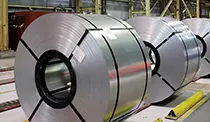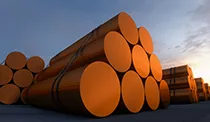1. THE MAIN PROBLEMS OF HEAT TREATMENT AND COATING PROCESS OF HIGH STRENGTH STEEL PLATE
The annealing and flattening process ultimately determine the mechanical properties, shape, and surface quality of the high-strength steel plate, especially for advanced high-strength steel that mainly phases transformation strengthening, the heat treatment system (annealing curve), and flattening elongation ultimately determine the structure of the material and mechanical properties.
At present, when almost all large-scale continuous heat treatment units in China produce high-strength steel plates with phase transformation strengthening, the cooling rate is always insufficient. Compared with other advanced units, when producing the high carbon steel plate of the same strength grade, more alloying elements must be added, and sometimes it is impossible to produce the desired structure and performance at all.
In addition, weld cracking will also occur. Due to the poor shape of the rolled hard material and the strip after rapid cooling, it is easy to cause difficulty in passing the plate, and the high temperature annealing causes the alloy elements to accumulate on the surface of the strip and lead to inaccuracy of temperature measurement. In the hot-dip galvanizing process, in addition to the above-mentioned problems, poor coatability of high-strength steel plates and difficulty in alloying also exist.
In the leveling process, whether it is cold high-strength steel or hot-dip galvanized high-strength steel, especially when the material strength level is high, it is difficult to achieve the required leveling elongation. Therefore, the shape of the high-strength steel plate, which was already poor before flattening, is difficult to be significantly improved through limited flattening deformation. Moreover, the ability to control the surface roughness of ultra-high-strength steel is also poor, and sometimes the roughness is almost unchanged during the leveling process.
In the electro-galvanizing process, the poor shape of the high-strength steel plate can easily damage the electro-galvanized equipment such as electrode plates and also affect the stable through-plate of the strip steel and the uniformity of the coating. In addition, the design basis of the electro-galvanized unit roll system is the steel belt strength grade, specification, and unit speed. When the strength level exceeds the design by more and the thickness is also large, not only is it difficult to pass the board but also affects the product quality.
2. FINISHING OF THE HIGH STRENGTH STEEL PLATE AND OTHER PROBLEMS
The finishing problem of high-strength steel plates, especially ultra-high-strength steel plates, is mainly the problem of shearing capacity. Almost all finishing lines in China can only cut high-strength steel below 80kg. The cutting of higher-strength grades of high-strength steel, or sub-coiling, and slitting need to add new units or optimize the old units.
Such as laboratory analysis and the continuity of the production organization of each process, are also more difficult problems to solve. In particular, the preparation of tensile samples of ultra-high-strength steel plates and the vibration and impact of the extensometer after tensile fracture of the samples are very complicated. Moreover, other special inspections and testing items need to be added for the super high strength steel.
For high-strength steel plates of various strength grades and specifications, it is also difficult to solve the production continuation problem of the continuous rolling mill and continuous heat treatment unit, which has a great impact on the normal production and state stability of the unit.






















